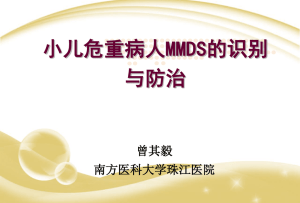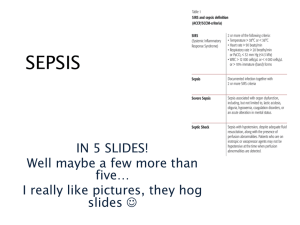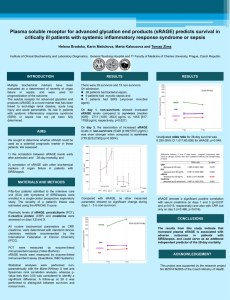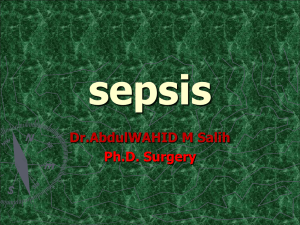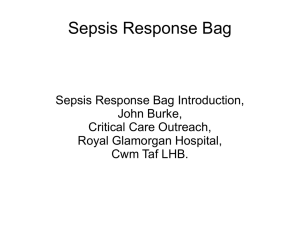Document
advertisement
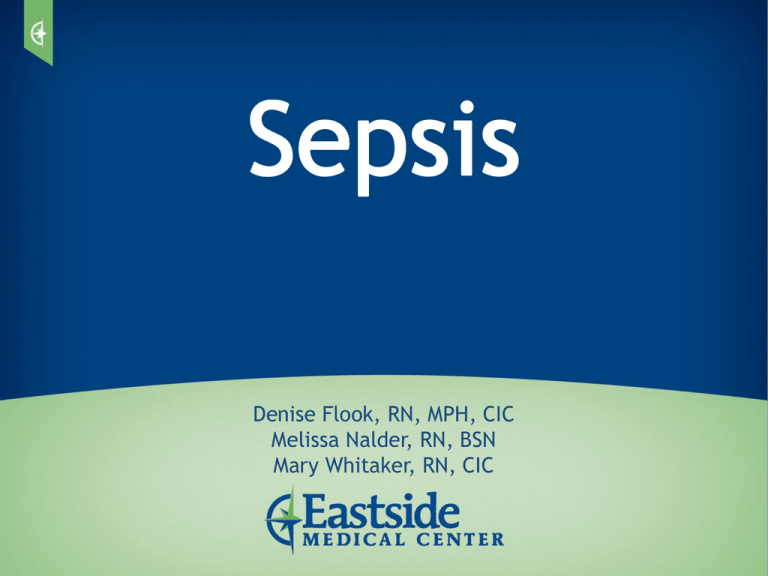
Denise Flook, RN, MPH, CIC Melissa Nalder, RN, BSN Mary Whitaker, RN, CIC Why did we start a Sepsis Program? • Sepsis was identified as a leading cause of mortalities in our facility. • Sepsis mortality rates were within national benchmarks, but still higher than corporate goals. • Every sepsis mortality was a person….someone’s loved one, friend. • Chart reviews demonstrated inconsistent identification and treatment of sepsis. Sepsis Statistics • Overall sepsis mortality rate for 1Q2014 was 31.7% • Septic Shock mortality rate for 1Q2014 was 40.3% • 3 hour bundle incomplete within 3 hours in 35% of patients. What did we do? • Convened a Sepsis Team and reviewed Surviving Sepsis Campaign best practices. • Held education sessions for physicians and staff presented by the President Elect of Society of Critical Care Medicine. • Developed posters for ED triage and nursing pods with SIRS criteria and the 3 and 6 hour bundles. • Revamped our Sepsis Alert Team and gave clearly defined expectations of the roles for each team member. • Developed evidence based order sets for the ED and inpatient areas. • Developed antimicrobial algorithms for appropriate coverage based on suspected source of infection and local antibiogram. • Provided education to our EMS partners to call Sepsis Alerts from the field as they do with STEMI and STROKE. • Identified methods to incorporate our MEWS system in Sepsis early identification. ED Triage Poster SEPSIS ALERT Suspected significant infection with 2 or more of the following: o Temp ≥ 100.4°F, ≤ 96.8°F o SBP ≤ 90 or MAP < 65 o Tachycardia ≥ 90 o o Tachypnea ≥ 20 or PCo2 < 32 Decreased Mental Status IMMEDIATELY initiate Resuscitation Bundle (complete within 3 hours) Obtain STAT Lactate Level Obtain Blood Cultures PRIOR to Antibiotic Treatment (Draw 2 sets 15 minutes apart) Administer Antibiotics (refer to antibiotic guide) Administer 30 mL/kg crystalloid Fluid Challenge For every hour in delay the patients risk of mortality increases by 8%!! Sepsis Alert Poster SEPSIS ALERT Suspected significant infection with 2 or more of the following: o o o o o o Temp ≥ 100.4°F, ≤ 96.8°F SBP ≤ 90 or MAP < 65 Tachycardia ≥ 90 Tachypnea ≥ 20 or PCo2 < 32 Leukocytosis ≥ 12,000 or ≤ 4,000 Platelets < 100,000 or INR > 1.5 IMMEDIATELY initiate Resuscitation Bundle (complete within 3 hours) Obtain STAT Lactate Level Obtain Blood Cultures PRIOR to Antibiotic Treatment (Draw 2 sets 15 minutes apart) o o o o o o UOP < 0.5 ml/kg/hr after fluid resucitation Creatinine increase from baseline of > 0.5 mg/dl Total Bilirubin ≥ 4 mg/dl (new onset) PaO2/FiO2 ratio ≤ 300 (mechanical ventilation) Decreased Mental Status New End Organ Dysfunction Criteria Met Septic Shock Bundle for persistent hypotension (complete within 6 hours) Apply Vasopressors (for hypotension that does not respond to fluid resucitation) Maintain MAP ≥ 65 mm Hg Measure CVP (target is > 8 mm Hg) Administer Antibiotics (for persistent hypotension despite fluid resuscitation or Lactate ≥ 4 mmol/L) (refer to antibiotic guide) Administer 30 mL/kg crystalloid Fluid Challenge Remeasure Lactate if Initial Lactate was > 4 mmoL EMS Poster SEPSIS ALERT Suspected significant infection with 2 or more of the following: o Temp ≥ 100.4°F, ≤ 96.8°F o SBP ≤ 90 or MAP < 65 o Tachycardia ≥ 90 o o Tachypnea ≥ 20 Decreased Mental Status IMMEDIATELY Call SEPSIS ALERT to ED Initiate Fluid Resuscitation For every hour in delay the patient’s risk of mortality increases by 8%!! Antimicrobial Coverage Algorithm Antibiotic Therapy Recommendations for severe sepsis/septic shock: administer first dose within 1 hour Pneumonia: Rocephin (ceftriaxone) 1 gm IV every 24 hours AND Levaquin 750 mg IV every 24 hours Rocephin (ceftriaxone) 1 gram IV every 24 hours and Azithromycin 500 mg IV every 24 hours Clindamycin 600 mg IV every 8 hours (if aspiration pneumonia suspected) Zosyn 3.375 Gm IV q 8 hours AND Levaquin 750 mg IV every 24 hrs (if pseudomonas risk) Risk for MRSA Add: Vancomycin 1 gm IV every 12 hours Vancomycin for pharmacy to dose Vancomycin ____q ____hours Zyvox 600 mg IV every 12 hours (Restricted to Infectious Disease & Intensivist Providers) Sepsis due to UTI: Gentamicin 5 mg/kg IV x 1 dose AND Choose One: Rocephin (ceftriaxone) 1 gram IV every 24 hours Cefepime (Maxipime) 1 gm IV every 6 hours Intra-abdominal sepsis/unknown source: Zosyn (Pip/Tazo) 3.375 gms IV every 8 hours Merrem 500 mg IV every 6 hours Skin and soft tissue infections: Unasyn (ampicillin/sulbactam) 3 grams IV q 6 hours If patient is allergic to PCN, use: Ancef (cefazolin) 2 gm IV q 8 hr If suspected abscess or risk for community acquired MRSA: Choose one: Vancomycin 1 gm IV every 12 hours Zyvox 600 mg IV every 12 hours (Restricted to Infectious Disease & Intensivist Providers) Recommendations based on SCCM, IDSA and SHEA Guidelines for Sepsis and local epidemiology and antibiogram Screening for Sepsis and Process Improvement • The recommendation is for routine screening of potentially infected seriously ill patients for severe sepsis to increase the early identification of sepsis and allow implementation of early sepsis therapy. • Sepsis Screening is built into every nursing assessment in EMR including ED. FOR EVERY 1 HOUR IN DELAY THE RISK OF MORTALITY INCREASES BY 8%!!! Since there were 2 or more “Y” to the queries in Tier 1 – the Nurse is automatically taken to Tier 2. These are only Y/N and the nurse has to answer them. The answers are not defaulted in Tiers 2 or 3. In Tier 2 – if either of the queries is answered “Y” – the Nurse is taken to Tier 3 Only 1 organ dysfunction in Tier 3 needs to be answered Y in order for a positive alert to be triggered How did we implement this? • Lots of education!!!! • Focus on Sepsis in every meeting • Engaged hospital leaders • Demonstrated how sepsis is everyone’s responsibility • Perseverance • Chart reviews and using data to guide changes to the program • Modeled the program after STEMI and STROKE programs • Looked for barriers in compliance • Got feedback from frontline staff during every step • Did we mention perseverance??? • Celebrated successes • Reviewed every fallout and used missed opportunities as teachable moments • Included physicians Lessons Learned • Check and double check that your EMR works as intended • Verify your data and coding • iStat ABGs with Lactate are a key to success. However, unless Wi-Fi enabled, the results do not reflect the time the test was done. • Engage the frontline staff in fixing the issues • If you have a program that works well such as STEMI or STROKE, build on that for Sepsis. “Time is Tissue” is true for all three. This helps build in a sense of urgency. • DO NOT GIVE UP!!!!!!!! • You are very unlikely to get it right the first time. We sure didn’t. • Celebrate successes and use your misses as teachable moments. • Do not assume everyone knows what Sepsis is. • You have to build accountability into the program. • Use existing systems: MEWS, EMR, iStat Opportunities • Sepsis screening tool does not work in all situations. • iStat has to be docked immediately to reflect accurate test time • Physician buy in is tough to hard wire…we are working on it • Non-present on admission sepsis alerts are not being called routinely • We still have fall outs. • We are not meeting the 3 hour bundle 100% of the time. Where are we now? Eastside Medical Center Sepsis Mortality Rates 2014 60% June 2014: Began our intense focus on improving sepsis 50% 40% 30% 20% 10% 0% Jan-14 Feb-14 Mar-14 Apr-14 May-14 Jun-14 Jul-14 Aug-14 Severe Sepsis Mortality Rate Jan-14 17% Feb-14 0% Mar-14 22% Apr-14 24% May-14 14% Jun-14 0% Jul-14 0% Aug-14 0% Septic Shock Mortality Rate 42% 25% 54% 25% 38% 35% 23% 0% Overall Sepsis Mortality Rate 36% 18% 41% 23% 29% 25% 19% 0% Success Story • 89 year old male • Past Medical History – Hypertension – COPD – Coronary Artery Disease – Chronic Kidney Disease – Hyperlipidemia – Recurrent Aspiration Recently discharged with pneumonia. • Presented to ED at approximately 4am with fever >104, AMS, Cough • Sepsis Alert called in triage. • All 3 hour bundle elements started within 34 minutes. • Admitted to ICU with Septic Shock, on Levophed • After 3 days in ICU, transferred to Medical Unit. • Discharged home on Day 8. A Family’s Perspective Questions
